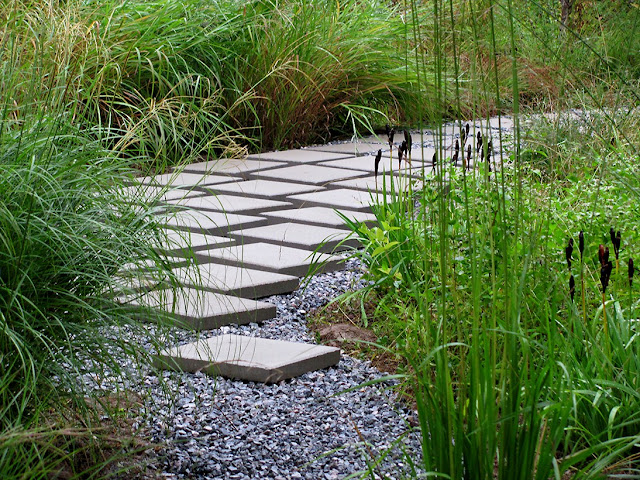Midway in life's journey, I found myself in a dark wood, for the straight way was lost.
- Dante, The Divine Comedy
A friend recently sent me a CD of photos he took in the garden last summer, almost exactly a year ago. He visited before I started replacing the messy, temporary wood chip paths--which had just washed away yet again in a heavy rain--with much more substantial gravel paths. This was a propitious gift; it helped me clarify my goals in this garden on Federal Twist Road.
(And that quote from Dante? I have to admit it doesn't at all express my own present state of mind, but I do believe it captures a universal human paradigm that we find in the subtext of many gardens, certainly in mine.)
When we bought the house five years ago, the land was covered with 50-year-old cedars. To make room for a garden, we had sixty or seventy cedars felled, chipped, and removed. I asked the contractor to leave several large piles of wood chips for use in making paths. At that time, I had no clear plan, but knew the chips would come in handy. As the garden took shape, I used the wood chips to lay out the paths that defined the garden. There were very few plants at that time, so these pathways were what defined the layout of the garden.
These chips were certainly useful and easy-to-work-with material but, over several years, they proved to have many disadvantages. They easily washed away in heavy rains, they decomposed and sank into the wet clay, they required constant replenishment, and possibly most important, they didn't make a pleasant walking surface. The garden is wet through most seasons, so the wood chips (above) often left visitors with an unpleasant sense of walking through a soggy field ... highly atmospheric, but not a pleasure up close ...
Last fall I began the laborious, and costly, process of building new gravel paths. (With help, of course; I couldn't transport those tons of gravel, by hand cart, myself.) The process took about seven months, with work only on weekends, and a long work stoppage during the heavy snow of winter. The new gravel path (below) makes a solid walking surface well above the wet. Even more importantly, the contrasting color and mass of the gravel add a strong visual structure, providing a clear sense of direction, making spatial relationships easier to grasp, and linking together the different parts of the garden.
Below, on the backside of the garden, you can see the old path tended to fade into the background ...
... while, in dramatic contrast, the gravel replacement (below) rather forcefully carries the eye through a series of curves ...
... and creates a strong sense of direction and anticipation. What is out of view just around the corner?
In August 2009, the path at the east end (below) was virtually disappearing ...
... but by August 2010, the gravel path (below) has become an armature guiding the view across the width of the garden, highlighting the shapes, colors, and textures of the plantings (and clearly showing where plantings need to be improved, especially along the more sharply defined path edges).
Similar story at the west end, which last year was a flat, static field, with little sense of anticipation, and a generally messy appearance...
... the gravel path (below) juts forcefully into the profuse plantings, creates a felt bodily desire to move forward, a beckoning.
Looked at from the high point of the house (to the upper left above), the paths draw out the subtle lines of the landscape--like a graphic or a musical interpretation of the hydrologic flow patterns of the land--calling to mind a river or a stream flowing across the surface and down the gentle slope toward the creek at the bottom of the valley.
The paths also function at a conceptual level; the sense of physical movement they create also suggests a metaphorical journey, and by extension a mindful questioning--certainly an age-old gardening concept, particularly in Japanese gardens. Thanks to that gift of a CD from a friend, I've been better able to articulate my intention to myself. (To find my way out of the woods, so to speak.) I'm aiming to create a sensually appealing environment, but one that goes beyond the physical environment to evoke a thoughtful repose and contemplation of larger questions.
Photos of bark paths by Ragnar Naess

























































